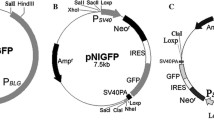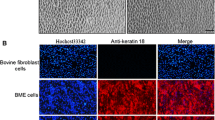Abstract
Human Fibroblast growth factor 1 (FGF1) has been recognized as a valuable protein drug for the treatment of many diseases because of its multiple functions in regulating a variety of biological processes involved in embryonic development, cell growth and differentiation, morphogenesis, tissue repair, and others. The aim of this study was to develop an FGF1 mammary gland-specific expression vector to produce FGF1 on a large scale from transgenic cows to meet the demand for FGF1 in medical use. In this study, we generated an FGF1 mammary gland-specific expression vector and validated its function in human MCF-7 cells. This vector was shown to successfully express functional FGF1, thus potentially enabling the generation of transgenic cows to be used as mammary gland bioreactors.








Similar content being viewed by others
References
Itoh N, Ornitz DM (2004) Evolution of the FGF and FGFR gene families. Trends Genet 20:563–569
Shing Y, Folkman J, Sullivan R, Butterfield C, Murray J, Klagsbrun M (1984) Heparin affinity: purification of a tumor-derived capillary endothelial cell growth factor. Science 223:1296–1299
Wiedlocha A (1999) Activation of the cell proliferation program by acidic fibroblast growth factor (aFGF). Postepy Hig Med Dosw 53:277–289
Burgess WH, Maciag T (1989) The heparin-binding (fibroblast) growth factor family of proteins. Annu Rev Biochem 58:575–606
Ornitz DM, Itoh N (2001) Fibroblast growth factors. Genome Biol 2:REVIEWS3005-1
Martin GR (1998) The roles of FGFs in the early development of vertebrate limbs. Genes Dev 12:1571–1586
Chen CW, Liu CS, Chiu IM et al (2010) The signals of FGFs on the neurogenesis of embryonic stem cells. J Biomed Sci 17:33
Basilico C, Moscatelli D (1992) The FGF family of growth factors and oncogenes. Adv Cancer Res 59:115–165
Naski MC, Ornitz DM (1998) FGF signaling in skeletal development. Front Biosci 3:d781–d794
Rosengart TK, Budenbender KT, Duenas M, Mack CA, Zhang QX, Isom OW (1997) Therapeutic angiogenesis: a comparative study of the angiogenic potential of acidic fibroblast growth factor and heparin. J Vasc Surg 26:302–312
Buehler A, Martire A, Strohm C et al (2002) Angiogenesis-independent cardioprotection in FGF-1 transgenic mice. Cardiovasc Res 55:768–777
Cuevas P, Carceller F, Martinez-Coso V et al (1999) Cardioprotection from ischemia by fibroblast growth factor: role of inducible nitric oxide synthase. Eur J Med Res 4:517–524
Everall IP, Trillo-Pazos G, Bell C, Mallory M, Sanders V, Masliah E (2001) Amelioration of neurotoxic effects of HIV envelope protein gp120 by fibroblast growth factor: a strategy for neuroprotection. J Neuropathol Exp Neurol 60:293–301
Guo F, Gopaul DN, van Duyne GD (1997) Structure of Cre recombinase complexed with DNA in a site-specific recombination synapse. Nature 389:40–46
Metzger D, Feil R (1999) Engineering the mouse genome by site-specific recombination. Curr Opin Biotechnol 10:470–476
Schmidt EE, Taylor DS, Prigge JR, Barnett S, Capecchi MR (2000) Illegitimate Cre-dependent chromosome rearrangements in transgenic mouse spermatids. Proc Natl Acad Sci USA 97:13702–13707
Dale EC, Ow DW (1991) Gene transfer with subsequent removal of the selection gene from the host genome. Proc Natl Acad Sci USA 88:10558–10562
Russell SH, Hoopes JL, Odell JT (1992) Directed excision of a transgene from the plant genome. Mol Gen Genet 234:49–59
Hare PD, Chua NH (2002) Excision of selectable marker genes from transgenic plants. Nat Biotechnol 20:575–580
Langer SJ, Ghafoori AP, Byrd M, Leinwand L (2002) A genetic screen identifies novel non-compatible loxP sites. Nucleic Acids Res 30:3067–3077
Bethke B, Sauer B (1997) Segmental genomic replacement by Cre-mediated recombination: genotoxic stress activation of the p53 promoter in single-copy transformants. Nucleic Acids Res 25:2828–2834
Araki K, Araki M, Yamamura K (2002) Site-directed integration of the cre gene mediated by Cre recombinase using a combination of mutant lox sites. Nucleic Acids Res 30:e103
Araki K, Araki M, Yamamura K (2006) Negative selection with the diphtheria toxin A fragment gene improves frequency of Cre-mediated cassette exchange in ES cells. J Biochem 140:793–798
Shin JT, Opalenik SR, Wehby JN et al (1996) Serum-starvation induces the extracellular appearance of FGF-1. Biochim Biophys Acta 1312:27–38
Strydom DJ, Harper JW, Lobb RR (1986) Amino acid sequence of bovine brain derived class 1 heparin-binding growth factor. Biochemistry 25:945–951
Crumley G, Bellot F, Kaplow JM, Schlessinger J, Jaye M, Dionne CA (1991) High-affinity binding and activation of a truncated FGF receptor by both aFGF and bFGF. Oncogene 6:2255–2262
Lozano RM, Pineda-Lucena A, Gonzalez C et al (2000) 1H NMR structural characterization of a nonmitogenic, vasodilatory, ischemia-protector and neuromodulatory acidic fibroblast growth factor. Biochemistry 39:4982–4993
Cuilliere ML, Tregoat V, Bene MC, Faure G, Montagne P (1999) Changes in the kappa-casein and beta-casein concentrations in human milk during lactation. J Clin Lab Anal 13:213–218
Kabotyanski EB, Huetter M, Xian W, Rijnkels M, Rosen JM (2006) Integration of prolactin and glucocorticoid signaling at the beta-casein promoter and enhancer by ordered recruitment of specific transcription factors and chromatin modifiers. Mol Endocrinol 20:2355–2368
Groner B, Gouilleux F (1995) Prolactin-mediated gene activation in mammary epithelial cells. Curr Opin Genet Dev 5:587–594
McManaman JL, Hanson L, Neville MC, Wright RM (2000) Lactogenic hormones regulate xanthine oxidoreductase and beta-casein levels in mammary epithelial cells by distinct mechanisms. Arch Biochem Biophys 373:318–327
Langle-Rouault F, Patzel V, Benavente A et al (1998) Up to 100-fold increase of apparent gene expression in the presence of Epstein-Barr virus oriP sequences and EBNA1: implications of the nuclear import of plasmids. J Virol 72:6181–6185
Rawlins DR, Milman G, Hayward SD, Hayward GS (1985) Sequence-specific DNA binding of the Epstein-Barr virus nuclear antigen (EBNA-1) to clustered sites in the plasmid maintenance region. Cell 42:859–868
Middleton T, Sugden B (1994) Retention of plasmid DNA in mammalian cells is enhanced by binding of the Epstein-Barr virus replication protein EBNA1. J Virol 68:4067–4071
Kirchmaier AL, Sugden B (1995) Plasmid maintenance of derivatives of oriP of Epstein-Barr virus. J Virol 69:1280–1283
Acknowledgments
This study was supported by a grant from the China National Foundation for Natural Science (13002104) to HO. All vectors constructed in this article are available from the authors upon request from academic researchers.
Author information
Authors and Affiliations
Corresponding authors
Additional information
Yang Zhou and Linzhu Ren contributed equally to this study.
Rights and permissions
About this article
Cite this article
Zhou, Y., Ren, L., Zhu, J. et al. Construction of a recombinant human FGF1 expression vector for mammary gland-specific expression in human breast cancer cells. Mol Cell Biochem 354, 39–46 (2011). https://doi.org/10.1007/s11010-011-0803-8
Received:
Accepted:
Published:
Issue Date:
DOI: https://doi.org/10.1007/s11010-011-0803-8




